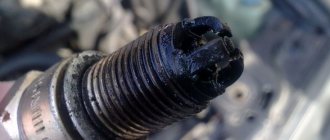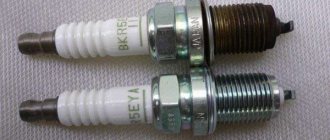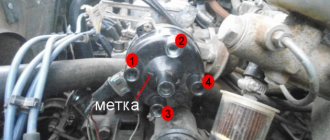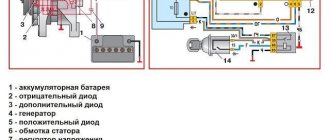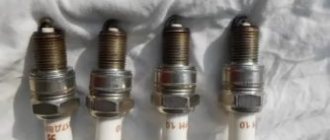Every day there are more and more cars equipped with an injector in operation. The effectiveness of use has been proven by many years of experience. The dynamic performance of the car increases, the “appetite” decreases, and the environmental friendliness of vehicles improves. But sometimes even for such systems there come moments when the spark plugs on the injector flood. It cannot be said that all drivers experience this, but many are aware of the problem.
Example of flooded spark plugs
Such parts cannot produce a full spark to ignite the air-fuel mixture.
Carburetor models are susceptible to this phenomenon much more often, since the culprit may be a carburetor whose adjustments have been disrupted. In injection engines, processes are controlled by an electronic control unit; it does not require driver intervention during operation of the machine. The question arises why the injector spark plugs are flooded. There may be several reasons, they do not differ from those that are typical for carburetor engine models.
Drivers and auto center mechanics note that problems begin to appear with the onset of cold weather. When preparing your car, you should carefully prepare the battery, ignition system, fuel supply system for winter, and fill in the appropriate engine oil. In many cases, this will save you from such troubles.
Studying plaque on candles
They say that when candles are “flooded,” black soot forms. Let us clarify: it should not consist of inclusions. All metal, in turn, will be covered with an oily coating. Dry carbon looks different...
Oily layer and dry soot
The photo shows two cases. “Our version” is on the right.
And soot can also be brown. And it always, in 100% of cases, is formed due to pouring gasoline.
An oily coating, as in photo 1, is, nevertheless, the result of oil ingress. But an oiled candle does not work correctly - it will also be “flooded”.
With regular “flooding,” carbon deposits form, which we see in photo 1 on the right and in photo 2. The rest does not apply to our case.
Remote start and auto warm-up
How nice it is to get into a warm car in winter! It's no surprise that remote start is the most requested service feature for car alarms. But you need to use it wisely. Remote start is fine as long as the car starts normally. Problems begin when the engine fails to start: the alarm may try to turn the starter over and over again, filling the spark plugs with gasoline and draining the battery. Therefore, in severe frost, experienced drivers prefer to start the car themselves - it’s more reliable.
Another relevant winter alarm function is autostart, which occurs without a command from the driver. Typically, automatic engine starting is programmed by time (for example, every 4 hours) or by a certain temperature, upon reaching which the engine should start and warm up. The main thing is not to overdo it: when the car is idled for a long time in winter, condensation accumulates in the muffler, which turns into ice after the engine stops. If the exhaust pipe inside becomes a solid icicle, you will no longer be able to start the car - you will have to warm it up in a warm box.
To reduce the time and frequency of night warm-ups, use a car blanket that will prevent the engine from quickly losing heat.
Why is good compression and rapid compression of the mixture important?
The process of combustion of the air-fuel mixture in cylinders
In order for a flash of the air-fuel mixture to occur, it must be compressed, and this must be done quickly enough - then the mixture will heat up and will be heated steam, only instead of water, it will contain gasoline as moisture. Such a mixture does not settle as a conductive film between the electrodes of the spark plug, and the spark discharge will not “go to ground”, but will ignite the mixture, which is also heated by compression.
Good compression in the cylinder ensures rapid compression and heating of the air-fuel mixture.
In the case when the compression stroke occurs slowly, the pressure in the cylinder will not become sufficient - the compressed mixture of gases will be released through the gaps between the parts. In addition, the thermal energy acquired by the mixture will be completely inappropriately used to warm up the metal parts, and gasoline in liquid form will be “delivered” to the electrodes of the spark plug and will safely flood it. A person who has at least once inflated bicycle wheels with a pump without a plastic coating on the cylinder can imagine this very clearly. If you pump intensively, the pump body will become very hot, and the proportion of its heating due to piston friction will be only a small part. This is easy to verify if you run the pump “idle” - without screwing the hose to the spool - the pump body will hardly warm up even after fifty cycles. So, why dynamic compression of the mixture is needed, and how it, in combination with good compression, favors the flash of fuel, we found out. But do not forget that in cold weather:
- battery energy decreases;
- The engine oil thickens, making it difficult for the starter to crank the crankshaft. The starter begins to consume more energy, which is also needed for a powerful spark.
All this happens without proper dynamics. It turns out to be a “vicious circle” - and the candles are filled with gasoline. All of the above can give a clear answer to the question: “can the spark plugs on the injector be filled in in cold weather?” Of course it can.
Checking compression in the cylinder with a compression gauge
There can be several reasons for low compression in the cylinders. When measuring compression, a compression meter is used.
But it happens that the candles are filled with oil. This is a separate case - engine repair is required. For initial diagnostics of the engine (not its control systems, namely the timing and timing gear mechanisms), you can use a compression meter. You measure the compression - the norm for a gasoline engine is 12 kg/cm2. If its value is significantly less than 10 kg/cm2, pour 30 - 50 grams of oil into the spark plug holes. If the compression has risen, repair the piston-cylinder pair, and this is already a “capital”. If the compression does not rise after filling the oil, there is a violation of the tightness of the combustion chambers - the valves do not fit tightly to the seats, they burn out, etc. If the values are the same, most likely the oil seals on the valve guides or the oil control piston rings are worn out. The rings, however, can “get stuck” in the piston grooves.
The main reason why spark plugs cannot ignite the air-fuel mixture in cold weather is a weak battery . In a battery discharged by more than 40-60%, there will not be enough current to start the starter and to supply enough voltage to the spark plugs until a spark is formed. As a result, fuel is properly supplied to the cylinders, but does not ignite due to a too weak spark - and the spark plugs are flooded.
Another reason why spark plugs flood in winter is a malfunction of the ignition system itself. Either the spark plugs have exhausted their service life - and then, due to incorrect gaps, defects in the housing and electrodes, they are not able to produce a normal spark, or the high-voltage wires and their contacts are damaged. It is also worth paying attention to other elements of the system, in particular the condition of the ignition coils.
Also, the cause of the failure may be in a complex of sensors and ECU : in cold weather, the electronic control unit receives information from sensors (mass air flow sensor, lambda probe, etc.) that the injectors should supply more gasoline to enrich the mixture. And if some sensor is lying, and the control unit enriches the mixture, the injectors overfill fuel - and the spark plugs drown in excess gasoline, unable to ignite it.
Fuel of low quality or with an admixture of water due to condensation on the walls of an empty tank also prevents the mixture from igniting, while the spark on the spark plugs may be normal. Therefore, in winter it is recommended to keep the fuel tank full and switch to gasoline with a higher octane number: AI-95 instead of AI-92, for example.
In real life, it is typical when the candles flood due to a combination of all factors.
Let’s imagine a not-new engine with some wear on the CPG (compression is still normal, but no longer ideal), a battery that has become weak in the cold, thickened oil in the crankcase, tired spark plugs, a half-empty tank of gasoline. And frost in the morning.
When the owner tries to start the engine, the ECU monitors the temperature outside and the temperature of the engine, the amount of oxygen in the air that enters the intake, etc. and “understands” that it is frosty outside, and the engine needs to be started so that it does not stall - and gives the injectors a command to increase the amount of gasoline supplied - so that the enriched mixture is enough for “warm-up idle speed”.
As a result, the injectors supply fuel mixed with water into the cylinders, the starter slowly cranks the crankshaft in thickened oil from a half-dead battery, and in a cold engine with increased clearances and less-than-ideal compression, the spark plugs try to ignite the fuel due to a weak spark. The result of this scenario will be flooded candles.
What to do if the candles are flooded
Measures to eliminate the malfunction directly depend on the reason why the engine is flooding them. Let's look at them in the same order.
When filling with gasoline
The first thing you can do is purge the cylinders for 10 seconds by opening or partially opening the throttles, making the mixture lean. You can also unscrew the spark plugs and clean, burn out (dry), and also check the gap and any other visible damage. It would also be a good idea to have a multimeter on hand to check the voltage at the battery terminals, it may be too low.
Do not attempt to start the engine again until the problem has been repaired. This way the candles will be filled even more.
How to start the engine if the spark plugs are flooded:
- If you fail to start the engine a maximum of the third time, then you need to wait about 5...10 minutes and then repeat the operation.
- Charge the battery or try to “light it” from another car.
- Unscrew the flooded spark plugs and replace them with a spare set. If it is not there, then you need to dry the spark plugs and check the condition of the electrodes, insulator, and metal.
- Try to start the engine with an already charged battery and dry spark plugs.
There is also a method on how to start the engine when the spark plugs are flooded. However, to implement it, you need a well-charged battery . So, when starting, you need to press the accelerator pedal all the way down and at the same time try to start the engine. On cars with a manual transmission, it is also advisable to depress the clutch to facilitate starting.
This is done so that the air that passes through the cylinders dries the spark plugs a little. And accordingly, the more air there is, the better the drying process will occur. On injection engines in this mode, the computer control system turns off the excess fuel supply and the spark plugs dry. As for carburetor engines, in a similar mode they do not create excessive pressure in the cylinders, but, on the contrary, a slight vacuum appears. This physical condition can also dry out the spark plugs a little and “squeeze” gasoline out of them.
If there is gasoline with water, then there are two ways to proceed. The first is to completely drain the low-quality fuel, flush the fuel system and fill in with new, high-quality gasoline. Another option is to use special moisture removers. These products are designed to neutralize the condensate present in gasoline. However, they are able to cope with only a small amount of moisture, so you should not expect a miracle from them.
When the problem is in the sensors or electrics, you won’t be able to start the engine until the faulty element is eliminated. True, whatever the reason, you shouldn’t suffer every morning - you need to look for and eliminate the cause!
When filling candles with oil
As we have already found out, it can be filled with oil both from below and from above. If you have oil in the wells (the insulator has flooded), then the first step is to remove the lubricant. This can be done with a syringe or a paper rag. How the problem itself is eliminated depends on the situation. Either change the gasket or seal it with sealant.
Throws oil at the electrode or candle thread - you can, of course, burn it out on the fire, but this will not solve the problem itself. If there is a strong oil leak into the cylinder you will not get very far; you need to eliminate the cause: change the seals, valve guides, or rebuild the engine and change the rings.
So, if there is a problem with the guides, it is necessary to replace them with a repair option. If this is done repeatedly, then you need to look at the diameter and select it based on the specific situation. If necessary, it is better to seek help from a car service center.
If oil oozes due to wear of the seals, then there are two possible repair options. The first is replacing valve seals. However, this option is only possible if the valve bushings are not very worn. Otherwise, new oil seals will similarly quickly fail. Therefore, the second option is to completely replace the guide bushings.
If there is significant wear on the valve guides, then it is necessary to replace both the valves and the guide bushings.
If piston rings fail, they must be thoroughly diagnosed. The fact is that the valves often fail with the rings, and the inner surface (mirror) of the cylinder is also damaged. If only the rings fail, they need to be replaced. If there are problems with the surface of the cylinders, then you can try to sharpen them. As for the valves, you need to look at their condition. Often they are also replaced with new ones.
If there is a high oil level in the crankcase, then you need to drain it to the MAX mark on the dipstick. However, if the mentioned level has risen due to antifreeze getting into the oil, then a large list of work must be performed. In particular, completely drain the oil, eliminate the cause of the breakdown due to the mixing of lubricating and cooling fluids, flush the cooling and lubrication system, and only then fill in new process fluids into the mentioned systems.
If the crankcase ventilation system is clogged, it is necessary to find and eliminate its cause. The test depends on the design of the system itself. Usually you need to check the pipes, oil separator, PCV valve.
If the intake manifold gasket has failed, then it only needs to be replaced with a new one. Naturally, you need to clean spark plugs and other elements from any motor oil that has gotten on them. A candle, for example, can be cleaned using a sandblaster.
When filling spark plugs with antifreeze
Most often, antifreeze appears in the oil due to the cylinder head gasket burning out or the geometry of the “head” being damaged. In this case, you just need to change the gasket and grind the surface, otherwise the problem will not be solved.
If the geometry of the engine cylinder head has been damaged, you need to contact a car service center for help. There, with the help of special machines (milling, grinding), craftsmen will restore its normal shape, in particular, the lower plane.
If the heat exchanger or its gasket is damaged, in most cases it is necessary to replace these elements, since they are practically irreparable.
In rare cases, not only the head, but also the cylinder block itself can change the geometry. This is a rather complicated case, and you need to seek help from a car service center. There, using special equipment, you can try to restore it. But, unfortunately, this is not always possible. Especially if the engine is old, has a high mileage, or is mechanically deformed, for example, due to an accident.
In older cars, antifreeze can get into the oil, and from there into the spark plugs due to leaking pipes and/or connecting clamps. However, in this case it is impossible to give specific advice, since it depends on the design of the particular car and the condition of its engine (rubber pipes).
However, the spark plugs are filled with antifreeze - this is the least that will happen in case of such a malfunction.
How to fix the problem?
Having bought a used car, the driver needs to know what to do when he fills the spark plugs. Despite the fact that the problem can occur with a new car, most often the spark plugs are flooded due to wear of certain parts. Wet spark plugs are one of the most common problems faced by both novice and experienced drivers. After this, the car stops starting.
Usually, experienced car enthusiasts simply replace the filled parts with dry ones. Knowledgeable drivers always have spark plugs in stock. To remove flooded appliances you will need a special wrench and an additional set of spark plugs. If you don’t have any tools at hand, you can just wait and not rotate the crankshaft. To allow excess fuel to evaporate, press the clutch and gas simultaneously. This is enough for a great launch.
Unfortunately, the presented method does not always work. Low-quality fuel, lubricant residues on the electrodes - all this provokes the appearance of deposits. Getting rid of them is not so easy. Ventilation won't help. Cleaning is necessary, which can only be done after removing the candles. Deposits are different. The problem depends on the color.
Why do the spark plugs on the injector flood?
When plugs are filled in on an injection engine, problems usually arise with starting it. For example, in the evening you returned from work, parked your car and calmly went home.
Morning comes, you need to go to work, but the car refuses to start. And the starter turns, but there are no signs of even attempts to ignite the fuel composition.
Therefore, a modern car enthusiast must be prepared for any surprises and be able to react to them correctly.
By the way, this phenomenon is typical for any type of fuel system (carburetor, injection - it doesn’t matter).
In most cases, trouble occurs in winter, when it is frosty outside. In the warm season, fuel filling the spark plugs on the injector occurs much less frequently.
So what to do?
Main reasons
First, let's look at the main reasons for this phenomenon. Surprisingly, the main source of problems in this case is the car’s ECU and the features of its firmware.
When it’s below zero outside, the system tries to create certain conditions for the fuel mixture. It is no secret that in frosty air the volume of oxygen is much higher.
So it turns out that the ECU sends an order to the injectors to supply a larger volume of fuel.
Naturally, “orders are not discussed” and the injectors increase the amount of gasoline injected.
Features of starting a car in cold periods
In cold weather, before starting, you must first load the battery, then disconnect it for a while. After waiting a few minutes, you can try turning the starter to start the engine. If you fail to start the car on the first try, then in order not to fill the injector, you must wait a few more minutes. If all preventive measures were carried out in full before the frost, then there should be no problems with filling fuel.
We can list several conditions that are considered optimal for normal operation of the injector:
- presence of a working starter;
- maximum battery charge. The battery is powerful and in good condition;
- seasonal lubricant is used;
- spark plugs and high voltage electrical circuits must be in perfect condition;
- clean, adjusted nozzles are installed;
- The gas tank is filled with high-quality fuel.
There is an opinion among experienced drivers that driving a car along the highway at a speed of 120 km/h helps to self-clean car systems, including the fuel system. You can also run the engine at 5000 rpm for about 10 minutes in the morning. The effect is similar to racing on a track.
It is believed that when high pressure is created in the systems, self-cleaning occurs. These measures can only be carried out if the car is in good condition and a significant increase in pressure in the systems will not harm it.
What steps do you need to take to get started?
The question arises, what to do if the car is not old, all systems are in order, but in the cold it refuses to start? When turning the spark plugs out, it turns out that they are wet. As already mentioned, in the cold season, the cause of this phenomenon may be weak compression, low-quality fuel or a weak battery.
Let's look again at the manufacturer's instructions. The book on car operation defines the following algorithm of actions:
- Turn out the spark plugs.
- Wipe them thoroughly and dry them.
- Run the starter for a few seconds.
- Put everything in place.
Often, car owners clean the injector using various fuel additives. This is not recommended at all, firstly, the quality of the fuel mixture is lost, which negatively affects the operation of the entire piston group, and secondly, the injector should be cleaned using special equipment.
Experienced drivers carry several sets of spare spark plugs with them . The quality of the spark produced depends on the technical characteristics of this ignition component. There is no point in saving on candles, their cost is not that high, and low-quality candles can cause a lot of problems.
What to do in this case?
Press the accelerator pedal all the way and turn the key in the ignition.
Crank the starter for 8-10 seconds . At the end of this time, the pedal can be returned to its original position.
In most cases, the engine starts.
The peculiarity of this method is that when the gas is fully pressed, the fuel supply to the engine is shut off, and the spark plugs themselves are blown exclusively with air.
If the engine still does not start, then you need to dry the spark plugs.
Pouring hot
Fortunately, candles are filled “hot” not as often as “cold”. This occurs when the engine starts, warms up, and then, after a short drive, suddenly stalls. After this, the driver tries to start the engine again, but this does not happen. After a short period of time, the engine starts. This means that the candles have flooded.
Reasons why the problem occurs when the engine is hot:
Spark plug malfunction.
Wiring problems.
Malfunctions in the distributor.
Sensors are not working properly.
Software glitch.
Often spark plugs are filled “hot” in a carburetor or injection engine. It is possible to solve the problem in carburetor engines. To do this, the mixture must be lean. A ten second purge will be required.
There is a spark, the starter turns normally, but the spark plugs are flooded
Quite often you can encounter a situation where there is a spark, the spark plugs are flooded, and the starter spins the crankshaft well. In such a case, the spark plugs may require a separate check, since the presence of a spark on them does not mean that the same spark will always be created under pressure. In other words, if there was a spark on the unscrewed spark plug, then after installation on the engine it may disappear. The reason is increased pressure in the combustion chamber, which is created during the operation of the internal combustion engine. To find out, you need to carry out diagnostics on a special stand for checking spark plugs, which simulates the operation of these elements taking into account high pressure (similar to the operation of spark plugs in the combustion chamber).
When starting the engine, the spark plugs flood
The presence of a spark on spark plugs does not always indicate their performance under high pressure. It happens that when checking an unscrewed spark plug, there is a spark, but when it is mounted, when a lot of pressure is created, the spark does not appear. There are special stands that test spark plugs under pressure. There are easier and simpler ways to check the functionality of the material: how to check the spark plugs yourself.
The problem of filling injector spark plugs can also be a malfunction of the bypass valve in the fuel rail. To check whether the bypass valve is working, measure the fuel pressure in the rail. The fuel supply must be strictly under the pressure specified for a particular engine. If fuel is supplied with under or over pressure, the spark plugs will flood.
Injectors are also subject to diagnosis. The electronic engine control system (ECM) sensor should also be diagnosed. Since the control unit decides to enrich the mixture or lean it, then if, for example, the coolant temperature sensor (DTOZH) does not work, the control unit receives incorrect temperature data and incorrectly distributes the fuel supply, the injectors begin to overflow fuel. It is also possible that the control unit itself has become unusable.
Why are the candles wet?
Sometimes a removed spark plug may be wet. This may be caused by gasoline, oil or coolant (antifreeze). Each of these liquids has its own determination methods.
We recommend: Replacing front and rear brake pads on Lada Kalina
Gasoline can be easily identified by its high volatility. By unscrewing the spark plug, the gasoline quickly dries out. Most often, filling with gasoline occurs when starting a cold engine. This can also happen due to incorrect ignition adjustment.
Oil on the spark plug electrodes may appear due to significant wear of the oil seals in the valves. Less commonly, the cause may be wear of the engine cylinder-piston group or breakage of the oil rings on the piston. Any of these faults requires immediate repair.
The amount of oil on the spark plugs can indicate how serious the problem is. When diagnosing, it is best to use a set of new spark plugs recommended by the car manufacturer, since droplets of oil are clearly visible on a clean insulator. The first stage is the appearance of small dark spots from burnt oil. This will not affect the performance of the spark plug in any way, but will indicate that there are still problems with the engine. The next stage of oil entering the combustion chamber will be the moistening of the lower threaded part of the spark plug. This condition of the spark plug will cause popping noises in the muffler at idle. They disappear as the engine speed increases.
Next is coating the end of the threaded part of the spark plug with oil. In this case, a spark may not appear. The result is frequent claps in the muffler.
The last stage is the complete wetting of the candle from below. In this situation, a spark does not form at all. Therefore, a cylinder with such a spark plug does not work. You can find out about this by regular claps in the muffler, which do not stop with increasing speed. The engine starts to stall.
If oil enters the combustion chamber with completely working fuel supply and ignition systems, then its combustion occurs on the electrodes of the spark plug. As a result, the oil does not have time to wet the candle. That's not to say it's good, but it's not too bad either. In this case, droplets of burned oil turn into ash. It accumulates on the electrodes, increasing their thickness. When the engine is running, the ash warms up well. This promotes further combustion of the incoming oil. It is easy to clean, but it is better to do this at the same time as replacing the valve seals. If you remove the ash from the candle, the oil may stop burning. Because of this, the spark may stop jumping, the spark plug will flood, and the cylinder will stop working.
Sometimes “traditional craftsmen” use the following methods to combat flooding of candles: install candles with a shorter skirt or with a higher heat rating, increase the spark voltage by putting on high-voltage tips, leaving a small gap. All these methods are short-lived, ineffective, and are dangerous for the condition of the car.
The reasons for the ingress of coolant may be the following: a poorly pressed cylinder head, a crack in it or in the liner body, a leaky carburetor heating system. As for the last reason, it is typical only for Japanese cars.
In practice, it is difficult to determine whether antifreeze enters the combustion chamber, since when the engine warms up, some holes may close as a result of metal expansion. Diagnostics must be carried out on a cold engine. To do this, you need to start the car for about 10 seconds. During this time, the candles will not have time to heat up and the cracks will not disappear. When the spark plug is removed, the coolant looks like dew drops.
When buying new spark plugs, you should be wary of counterfeits, as they can cause the entire engine to fail. They can be identified by a crooked or uneven inscription, poor-quality processing of the hexagon of the candle, or poorly executed packaging.
Fills spark plugs with engine oil
In addition to the fact that the spark plugs can be filled with gasoline, there are common cases when the spark plugs in the engine are filled with oil, a spark plug in one cylinder is filled with oil, etc. This malfunction occurs both on the injector and on engines with a carburetor.
After unscrewing the spark plug, obvious black deposits may be visible or absent on the threads; oil may also fall from the well directly onto the threads while unscrewing the spark plug, etc. In the case when the spark plugs are filled with oil from below, that is, in the cylinder itself, then the compression in the engine should be measured. There is a high probability that the oil scraper rings are badly worn, cracked or stuck. It is also possible for cylinder walls or liners to wear out, oil seals (valve seals) to fail, cracks to appear in the cylinder head, problems with valve guides and other malfunctions that lead to increased lubricant entering the combustion chamber and oiling of the spark plugs.
How to understand that the candles are flooded
First of all, you need to define the concept of “drenched candles”, that is, what is it? One of the main operating cycles of a gasoline internal combustion engine is the supply of a fuel-air mixture to the combustion chamber and its subsequent ignition. When, for some reason, the spark plug does not light it, this is called “flooding the spark plugs.”
And all because a large amount of fuel gets into the electrodes and the spark plug body. And the more fuel that gets there, the more difficult it is to ignite it, although in practice this is almost impossible until they are dried.
Most often this happens during the cold season, during significant frosts or simply during cold snaps. As drivers say, “in the cold.” During such a period, there is a heavy load on the battery and if it is weak, then there is always the possibility of flooding the spark plugs. That is, the driver tries to start the car two or three times, while the battery is discharged and the spark plugs are filled with gasoline.
However, spark plugs can be filled with more than just gasoline. two other process fluids can get on it - engine oil and coolant (antifreeze or antifreeze).
Indirect signs that the spark plugs are filled with engine oil are the following situations:
- rapid decrease in oil level in the engine crankcase;
- Unstable engine starting, and at any time of the year;
- decrease in the dynamic characteristics of the car, poor acceleration, drop in power;
- Unstable engine operation at idle speed;
- "triple" of the engine.
It is necessary to understand that the listed signs may indicate other breakdowns in the engine, so it is better to unscrew the spark plug/s from its seat and visually assess the condition of its electrodes and insulator. Moreover, it is advisable to check both for the presence of burnt oil and for the general condition. Much can be understood by color.
Similar signs will indicate that the spark plug is filled with coolant (antifreeze). In this case, there will also be a drop in engine power, a rapid drop in the coolant level, and the appearance of white carbon deposits on the spark plug electrodes and/or its insulator. You may also notice the appearance of white smoke from the exhaust pipe.
How to do it?
The tools you can use are a regular toothbrush (or a metal brush) and a hair dryer (for more effective drying).
If you have the opportunity to take the candles home, you can “calcinate” them in the oven or directly on the burners. But this method is only temporary.
If the candles have already expired, then it is better to simply change them.
It happens that almost every day the spark plugs on the injector are filled. In such a situation, it is necessary to carry out a full check of the elements - for the presence of spark output, cleanliness of the injectors, quality of the spark, and so on.
Possible solutions to the problem of flooded candles
The manufacturing plant has already foreseen the situation in which the spark plugs splash, and VAZ, for example, has the corresponding instructions in its passport. Basic recommendations for actions if fuel gets on the spark plug, which is called “cold”:
- Remove the candles.
- Crank the starter for 15 minutes without spark plugs.
- Wipe and dry the spark plugs well, then install them in their original place.
There is an alternative, so-called “folk” method. It must be applied even before the spark plugs are removed:
- Press the gas pedal all the way.
- Crank the starter for 10 -15 seconds.
- Return the pedal to its place.
Since at this moment there is no supply of fuel mixture, the spark plugs are purged and dried with air. If all else fails, remove the wet spark plugs and dry them thoroughly. Depending on the conditions, you can dry it over any heat source - fire, gas stove, hairdryer.
Calcination shortens the life of candles, so you should not heat them for a long time. After drying, the gap must be checked; if necessary, the gap is adjusted and the spark plug is installed in its place. If everything is done correctly, the engine should start.
Injection and carburetor spark plugs are practically the same, so the methods used can be used in both cases. If the spark plugs on the injector are flooded in the warm season, diagnostics of the fuel system and the sparking mechanism is necessary. If necessary, it is necessary to replace faulty components. At the same time, the condition of the injectors is checked, as well as the functionality of the Hall sensor.
Why does it flood the candles when it’s cold?
If the spark plugs become wet in the summer, the car will start. And if it’s flooded in winter, it usually won’t start.
Signs of flooded candles are:
- The starter turns the crankshaft, but the engine still doesn’t want to start.
- When you try to start the car for a long time and the engine does not start, there is a strong smell of gasoline coming from the muffler.
- When dismantling a flooded spark plug, its thread and electrode are wet, and there is dark carbon deposits at the bottom of the spark plug, where the spark is produced.
Fills spark plugs on both injection and carburetor engines. Injection engines are flooded less frequently than engines with carburetors. If contactless ignition is installed, then it can still contribute to the production of a spark in the candle, because contact converts energy up to 18 kilovolts, and contactless electronic up to 24 kilovolts.
If the fuel-air mixture in the cylinder misses ignition, there is a lot of it, as a result of which the fuel mixture is not able to ignite in subsequent cycles.
Reasons for flooding spark plugs of injection and carburetor engines:
- Insufficient battery charge. Sealed, maintenance-free batteries must be charged according to strict rules. Low battery charge is the reason for flooded spark plugs, mainly in injection engines, since the injector and a bunch of stuffed electronics consume a lot of energy resources, a powerful battery is needed.
- There is a problem with the ignition system. This is either broken spark plugs or high-voltage wires. Old spark plugs may produce an infrequent spark or a misfire if the tip gap is not within normal range. High-voltage wires are also often punctured if they are of poor quality.
- Gasoline is of very low quality. Nowadays, private gas stations are common; it is enough to obtain the appropriate permits and start selling fuel. As a rule, no one checks the quality. Therefore, you should refuel at reputable large gas stations. Due to bad gasoline, condensation collects in the fuel system. Problems with starting a car in the cold season with low-quality fuel are especially noticeable.
The electronic control unit of the injection engine determines the outside temperature and the engine temperature, determines the oxygen content of the air flow entering the engine. Next, the control unit sends a signal to the injectors to increase the supply of injected fuel, which helps create a rich fuel-air mixture for reliable engine starting in cold weather.
Why doesn't the car start from auto start? It could be frost, or maybe ignorance of a little trick.
Cars with high mileage have a certain wear of parts of the cylinder-piston group; compression in the cylinders, accordingly, becomes less, but within acceptable limits. With low compression, when the spark plugs are flooded, it is more difficult for the engine to start. With high compression, if the spark plugs are working, the fuel-air mixture can still ignite, even if the fuel is not of high quality.
Low compression, thick engine oil, weak battery - all this makes it difficult to start the engine. The following happens:
- low quality fuel is supplied;
- the crankshaft rotates slowly due to engine oil thickened by frost, the battery is not charged enough;
- due to the fact that the engine is cold, the compression in it is lower than in a heated state;
- generation of a weak unstable spark.
In order to fill the spark plugs, you just need to try to start a car with a weak battery.
About the reasons for such problems
When the engine cranks with the starter, the “brains” of the car send control impulses to the fuel system, which are received by the ignition system and other units. To ignite the air-fuel mixture, it must be compressed in the cylinder; this occurs when the piston moves in the engine cylinders. There are no problems on new engines, the mixture is compressed and is easily ignited by a spark plug. After long-term operation, gradual wear of the piston rings and cylinder bore occurs, which reduces the compression ratio in the cylinders.
In cold weather, when starting the engine, the electronics indicate an increase in the volume of fuel in the working mixture. The fuel supply system and injectors follow commands, which can lead to flooding of spark plugs.
Comparison of new and flooded spark plugs
What other reasons could there be? The culprit may well be a poorly charged battery that does not provide the required crankshaft rotation efficiency. If it is possible to recharge the battery or “light up” from another car, the problem will be solved. Motor oil whose viscosity does not match the season makes it difficult to rotate the shaft. The ignition system gives an impulse to the spark plugs, the starter rotates slowly, so ignition does not occur.
You should pay attention to the quality of the fuel used; not all gas stations meet the required standards. The car's operating instructions instruct you to fill the tank with 95 gasoline, so it's better to do so. In summer, the use of low octane fuel may be acceptable, but in winter its volatility is worse. On engines with low compression, this can cause spark plugs to flood.
If we briefly summarize the reasons for pouring candles, they will be as follows:
- Weakly charged battery;
- Low quality of gasoline used;
- Wear of the engine piston group;
- Condition of candles;
- Correct operation of the injectors.
How to solve a problem
If the power unit does not start up the first time, the instructions recommend “blowing” the engine. To do this, with the gas pedal fully pressed, crank the engine with the starter for about 10-15 seconds. If this does not help, you will have to unscrew the spark plugs and dry them.
Drying spark plugs on a gas stove at home.
When the spark plugs are turned out, the cylinders should be blown out. On injection engines, it is advisable to exclude the supply of gasoline to the fuel rail; to do this, simply remove the fuel pump fuse. You can dry candles in different ways; there may be mechanical, manual or chemical methods for cleaning candles. There is no point in recommending any of them, since if this happens far from the garage, you won’t be able to warm it up on a gas stove.
Experienced drivers with cars with significant mileage have a spare set of spark plugs so that they can be replaced at the right time. If the problem recurs at regular intervals, the engine systems should be diagnosed. Spark plugs for the quality of the produced spark, a coil for the high-voltage voltage, injectors for the quality of fuel atomization.
How to act to avoid trouble
- firstly, you need to monitor the battery charge level and check it periodically (this is especially true in winter);
- secondly, check the serviceability and if any problems arise, do not be lazy to go for diagnostics;
- thirdly, only the best quality, which is suitable for use in winter;
- fourthly, promptly change and inspect high-voltage wires for the fact of their probable failure;
- fifthly, regulate and. This is easy to do - add one of the special compounds that are sold in stores to the tank;
- Sixth, use high quality. To do this, refuel at trusted gas stations.
Remember that in the cold season the engine does not like small trips at low speed.
Hello, dear car enthusiasts! Maybe not all, but many motorists are faced with this problem: yesterday I arrived, put the car in the garage, everything was fine. This morning I started to start the engine, but it would not start.
There could be a number of reasons for this
But today we will look at the most common one - filling the spark plugs with gasoline, it doesn’t matter whether you have an injector or a carburetor. Fills spark plugs with gasoline regardless of the type of vehicle fuel system
It is characteristic that the spark plugs are filled with gasoline less often in the warm season, and more often at sub-zero temperatures. So let’s try to figure out in order: why the spark plugs in the injector are flooded, what to do to start the engine at the exact moment when they are flooded, and how to prevent them from being flooded with gasoline in the injector.
Reasons why the spark plugs in the injector flood
In principle, the reason why the injector spark plugs flood is simple. And the tones lie in the peculiarities of the “electronic brain” of your car.
At subzero temperatures, mixing the fuel-air mixture requires some effort: more oxygen in cold air requires more gasoline. Accordingly, the ECU gives a command to the injector nozzles to increase the fuel supply, which they do in good faith.
And the following happens in the engine, especially if your car no longer has a new battery. The injectors supply fuel to the combustion chamber, the starter tries to create the necessary compression in the cylinders, while at the same time trying to provide a spark to generate a flash. Do not forget about the quality of fuel, which does not have ideal parameters.
As a result, with ideal compression, the injector spark plugs can start even with a minimum impulse, but ideal compression is only found in a new car. Actually, this is why, as a rule, the injector spark plugs of a new car do not fill.
The spark is weak, compression in the cold does not correspond to the parameters, and the injectors continue to supply fuel to the combustion chamber. Which, in turn, floods the candles and they simply stop showing signs of fiery life.
This is the answer to the question - why are they filled in on the injector?
There are two options for resolving the issue. As a rule, the “smart” operating book says: if the injector spark plugs are filled with gasoline, you need to unscrew them and dry them. With the spark plugs removed, crank the starter for 10-15 seconds. Put it back in and start the engine. These are actions according to the manufacturer.
A proven popular driving method. If your spark plugs are filled with gasoline, before unscrewing and drying them, try to start the engine in the following way: purge mode.
For the injector: the gas pedal is pressed all the way to the floor. Use the starter to crank the engine for 10-12 seconds, release the gas pedal. The engine should start. The fact is that in this way, by cutting off the fuel supply, you blow air through the spark plugs.
The engine did not start. Then try to dry them. Spark plugs for an injector are, in principle, no different from a carburetor engine. Therefore, we again use the “old-fashioned” method: we unscrew them, clean them from carbon deposits with a metal brush, or a toothbrush, and dry them either with a hairdryer, or on a gas stove or in the oven. We check the gap and screw the spark plugs for the injector into place. The engine should start.
If the story of filling the spark plugs with gasoline repeats itself every morning, you need to carry out diagnostics: spark plug quality, injector cleanliness, spark output from the ignition coil, Hall sensor.
What you need to watch out for so that the spark plugs are not flooded with gasoline
To ensure that such a problem, when the injector fills the spark plugs with gasoline, does not arise in the future, it is necessary to ensure that the following conditions are met in the car:
- battery is normal;
- starter is ok;
- normal oil should be poured in that can withstand frost;
- The spark plugs and high voltage wires must be in order;
- the injector nozzles are cleaned and adjusted correctly;
- Only high-quality fuel is filled and only high-quality fuel is always filled.
And the most important thing to do with a car so that the spark plugs never flood with gasoline is to let the engine “sink,” that is, organize races several times a month and spin the engine up to 5000 rpm for 10 seconds. After such a load, all carbon deposits and other deposits in the combustion chamber will be blown into the pipe.
You can also go long distances and drive at high speed, for example, it is advisable to drive 100 km at a speed of 120 km/h, you can do more if it’s not scary. Then the engine will feel great.
If there is no need to travel that far, then just spin the engine to 5000 rpm a couple of times a month. And for those who every time abruptly leave a traffic light at high speeds, such a problem as filling the spark plugs with gasoline does not exist at all.
It will also be interesting: Lada Vesta Cross: 1.8 engine (21179) and its technical characteristics
The following is a video about what to do if the candles are flooded with gasoline in the cold, what to do in this situation:
Causes of the problem and a set of solutions
If the spark plugs are actually filled with gasoline when starting the engine, then you need to check how well the spark is being formed in the engine. You may have to unscrew each of the spark plugs sequentially, after first removing the high-voltage connectors. The ignition must be turned off. It is advisable to disconnect one of the battery terminals too.
What to check:
- There should be no carbon deposits on the spark plug contacts;
- The distance between the contacts must correspond to the “passport value”.
The bad news is that the cause of unstable spark formation can be poor quality wiring or any malfunction in the ignition control system. Sometimes finding the causes takes longer than eliminating the defect. In such cases, it is difficult to do without the help of professionals. Don't overestimate your strength.
By the way, you can try to reason logically. The controller regulates the concentration of the mixture based on air temperature values. And these values are determined according to the readings of a single sensor - DTOZH.
Any temperature sensor is a thermistor
We are, of course, talking about the coolant temperature sensor.
The readings from the antifreeze temperature sensor may actually be underestimated. Then don't be surprised if the mixture is too rich in fuel. The recommendation to fix the problem seems trivial. The sensor needs to be replaced.
Note that in modern engines, to calculate the mixture concentration, not one temperature sensor is used, but several. An air heating sensor installed in the intake manifold can also be used. But the presence of engine oil in the manifold is not uncommon. And imagine what will happen if liquid gets on the body of such a sensor.
The controller program is designed so that the main source of information about air temperature is the DTOZH sensor. In modern engines, where many temperature control elements are used, this statement is also true.

